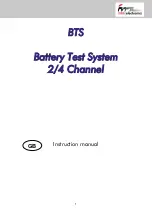
English
4
Symbols:
You must obey the safety instructions.
Read the user instruction before use
For indoor use only
Do not use in a damp environment or in rain.
Do not dispose of the BTS as household garbage.
In order to save the environment it must be disposed of with care in
accordance with local regulations.
The BTS meets the CE requirements valid in Europe.
2.
Safety instructions
-
Do not charge the Li-ion battery at temperatures below 0°C. First transport the Li-ion battery
and the BTS to a location where the temperature is higher and then start the test/charging
procedure.
-
Charge specified batteries only. Do not recharge non-rechargeable batteries.
-
Charge the batteries only if there is proper ventilation. Especially around the batteries. While
charging, a small amount of explosive gasses can be generated in the batteries.
inadequate ventilation in combination with open fire or sparks can lead to dangerous situations.
-
Do
not
connect or disconnect the battery while the BTS is testing the battery. E.g. to reduce risk
of sparking.
-
Batteries are capable of providing a lot of energy in a short time span. Prevent short circuits in
any way. For example walking over the cables or damaging the cables or connector by improper
use.
-
Only use cables supplied with the BTS.
-
Do not use the BTS if the cables are damaged.
-
If the power cord is damaged, it must be replaced by the manufacturer, its service agent or
similarly qualified persons in order to avoid a hazard. If the BTS is defective, do not try to repair
it.
-
The BTS should never be used in a very damp or wet environment (for instance outdoors), never
poor fluids over it or submerge it in water.
-
The system must not be exposed to chemical substances or vapours.
-
Make sure the BTS is positioned stable.
-
Keep a free zone of 20cm around the BTS to ensure that heat, generated during operation, can
be removed.
-
Do not place the BTS in direct sunlight.
-
Do no place the BTS in an environment that contains mechanical vibrations(i.e. Compressors,
etc.) or where a lot of heat is generated(Heaters, Ovens, etc.).
-
The ventilation slots of the BTS have to be kept free of excessive dust built up.
-
Make sure the BTS is connected to an appropriately earthed wall outlet.



















